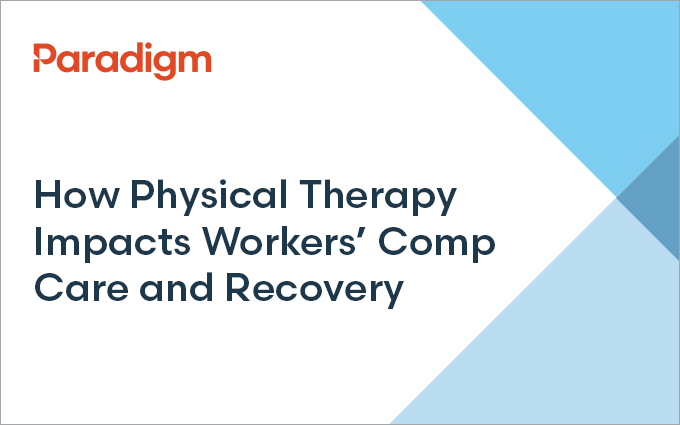10/21/2021

October is National Physical Therapy Month, commemorated by the American Physical Therapy Association (APTA) to raise awareness of the benefits of physical therapy and rehabilitation for patients. Physical therapy is designed to assist people dealing with a wide range of conditions and injuries, and it can also play an essential role in surgical recovery. Through a functional and holistic approach, physical therapists help patients improve strength and range of motion to regain their previous activity level.
Due to the nature of many workplace injuries, physical therapy often plays a key role in an injured worker’s recovery. From complex injuries, such as shoulder or knee sprains, to catastrophic injuries that can include limb loss, it is often a critical step between recovery and getting back to life and work. “Physical therapy is extremely important in nearly any injured worker’s recovery,” says Paradigm Network Manager Danita Williams. “It helps patients build back core strength, redevelop balance and coordination, and educates them on how to move properly and prevent future injuries.”
In recognition of National Physical Therapy Month, Paradigm is proud to highlight the positive impact of physical therapy on workers’ compensation care, recovery, and return to work. We spoke to both Danita and Paradigm Physical Therapy Clinical Specialist, Downey Hinrichs, MSPT, CLCP, for more insight on the difference that physical therapy makes in the lives of the injured workers we serve.
Getting workers moving and functioning again
Workplace injuries typically result in loss of function. Whether this is a temporary change due to a fairly minor injury or a life-altering event, patients need guidance to regain mobility. “Many of the injured workers we help are scared. Someone might not be able to turn correctly or even walk without re-injuring themselves,” says Danita. “Working with a physical therapist helps strengthen the muscles while teaching how to safely ambulate—with the ultimate goal of getting back to daily activities and work.”
Downey adds, “Physical therapy really focuses on improving the body’s natural strength, flexibility, and mobility to get people back out into the community, whether it’s walking level, wheelchair level, or with the help of prosthetics.” In workers’ compensation, these two experts agree that successful outcomes require cooperation and coordination among case managers, physical therapists, and injured workers.
“When we get together, we’re able to combine what we see, and sometimes we can figure out what an issue really is, and how to build a bridge between the rehab setting and the home,” says Danita. Both stress that the workers who commit to the therapy program as prescribed are frequently the ones with the best chance of achieving positive outcomes.
Overcoming obstacles to health and function
Danita worked with Downey on one recent case where persistence and adaptability made a meaningful difference. With her background in catastrophic rehabilitation, Downey has extensive experience using specialized techniques in conjunction with medical equipment to enhance independence and mobility. “Danita and I worked together to help an injured worker who had suffered from not only bilateral amputation, but severe abdominal impairment,” explains Downey.
Patients with lower-limb loss rely heavily on their core strength in learning to function with prosthetics. “We had to explore different supports, including braces and binders to support the abdominal wall, since the musculature wasn’t there to support himself,” says Downey. Adds Danita, “Downey’s vast background in dealing with multiple trauma came into play, and really helped out a lot with this case. She also developed adaptable solutions that helped the outcome and saved on cost, including modifying the patient’s prostheses as an alternative to creating new ones.”
Through both of their efforts, this injured worker is currently reintegrating back into the community. Thanks to vehicle and driver’s license modifications, he is proud to be taking on household responsibilities, including driving his children to and from school.
Help raise awareness during Physical Therapy Month
Throughout the month of October, the APTA encourages you to keep the conversation going on physical therapy by following them on social media and using the hashtags #ChoosePT and #PTmonth in your related social media posts. We also invite you to visit Paradigm’s social media channels, including Facebook, LinkedIn, and Twitter to show your support.